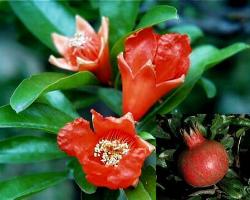December
2002
Did you
know that the pomegranate (Punica granatum) is considered as the oldest continuously cultivated fruit
tree?

|
|
Pomegranate
(Punica granatum)
|
Pomegranate
(Punica granatum)
Steeped in history and romance and almost in a class by itself, the
pomegranate, Punica granatum belongs to the family
Punicaceae which includes only one genus and two species, the other
one, little-known, being P. protopunica is found on the island of Soqotra off the southern coast of
Yemen.
The pomegranate (Punica granatum
Linnaeus) is considered the oldest continuously cultivated fruit tree. The pomegranate is native to the area between Iran and northern
India, and has been cultivated since ancient times throughout the Mediterranean basin to
India, where it is still cultivated today in largest quantity. The plant was used in many
ways, including juice, drinks (Grenadine), dyes, inks, tannins for leather
(bark) and a variety of remedies for various ailments. The generic
term, Punica, was the Roman name for Carthage
from whence the best pomegranates came to Italy. The Phoenicians and Arabic traders introduced pomegranates throughout much of the ancient
world. The fruit was used in many ways as it is
today and was featured in Egyptian mythology and art, praised in the
Old Testament of the Bible and in the Babylonian Talmud, and it was
carried by desert caravans for the sake of its thirst-quenching juice.
In Greek mythology, Pluto kidnapped Persephone carrying her into the
underworld. He offered her a pomegranate of which she ate a few pieces of the pulp from the
seeds. This action condemned her to spending half of the year with Pluto
(winter) and half with the world of the living (summer). Pomegranates were represented on Carthaginian
and Phenician medals and on the reverse of the coins of the island
of Rhodes. In Greek mythology the pomegranate is very conspicuous, and symbolizes fecundity and
abundance. The fruit was dedicated
to Juno, a deity always represented in sculptures as holding a
pomegranate. The Greek authors, e. g., Theophrastus, describe the
pomegranate under the names of "roa" and "roa side";
also Dioscorides, who quite explicitly sets forth the medicinal
properties of the different parts of the plant.
The pomegranate is a shrub, usually with multiple
stems, that
commonly grows 6-15' tall. The slender branches start out upright then
droop gracefully. Unpruned shrubs have a decidedly weeping or fountain-shaped
habit. The deciduous leaves are shiny and about 3" long.
Pomegranates have beautiful orange-red trumpet shaped flowers with
ruffled petals. The flowers are about 2" long, often double, and
are produced over a long period in summer. The pomegranate fruit is
globose, 2-3" in diameter, and shiny reddish or yellowish green
when mature. It has a persistant calyx opposite the stem end that
looks like a little crown. The fruit is technically a berry. It is
filled with crunchy seeds each of which is encased in a juicy,
somewhat acidic pulp that is itself enclosed in a membranous skin. The
seeds, juice and pulp are eaten, but the yellowish membrane is too
astringent.
Because of its long history of
cultivation, folklore and non-food uses of the pomegranate are many. It is popular in Egyptian
mythology, the bible, and other ancient writings. It was a symbol of fertility in many ancient
cultures. The bright red juice was often used as an ink in ancient
times. The fruit has a fairly long shelf-life at room temperature, and hence was carried on long journies through desert climates as a source of water and
nourishment. Today, pomegranates make nice ornaments for fruit bowls or Christmas
wreaths, as the fruit are marketed around the holiday season.
Source:
http://www.hort.purdue.edu/newcrop/morton/pomegranate.html
http://www.uga.edu/fruit/pomegran.htm
http://www.floridata.com/ref/p/puni_gra.cfm
http://www.geocities.com/boonehistory/punica.html
http://www.killerplants.com/plant-of-the-week/20020527.asp
|
